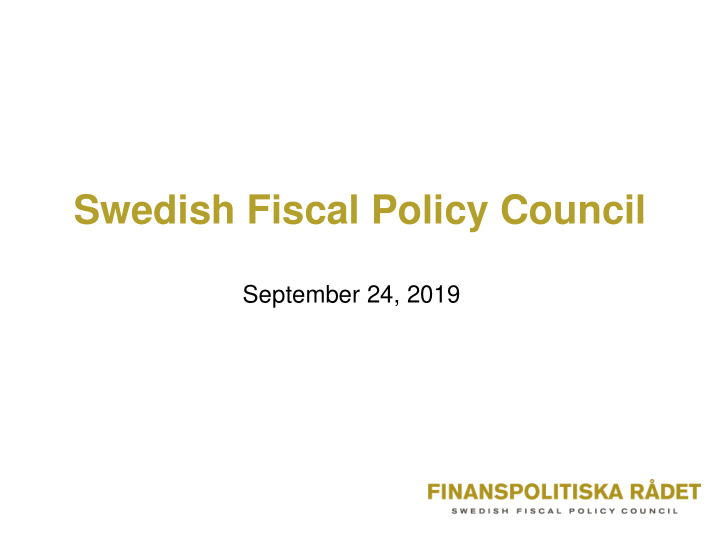



Swedish Fiscal Policy Council September 24, 2019
The set-up of the council Established in 2007 An agency under the Government Six members: Academics Policy-making experience Supplementary to regular jobs (mainly academic positions) Small secretariat: five staff Annual budget approx. SEK 10 million (Euro 1 million) 2
THE RIKSDAG GOVERNMENT (Parliament) Committee on Finance Ministry National of Finance Central Bank Audit Office (Riksbanken) (Riksrevisionen) National Financial Swedish Fiscal Management Authority National Institute Policy Council (Ekonomistyrningsverket) for Economic Research Council (Konjunkturinstitutet) Chair: Agency Harry Flam 3
The Swedish Fiscal Framework (1) • Top-down budget process (preparation in Government as well as decision in Parliament); • A fiscal surplus target for general government net lending of 1/3 percent of GDP, on average, over the business-cycle; • Central government expenditure ceiling set 3 years in advance; decision by Parliament; • Balanced budget requirement for local governments; • No sanctions for violations, but political cost 4
The Swedish Fiscal Framework (2) Changes in 2019: • The surplus target reduced from 1 percent to 1/3 percent. • Debt anchor introduced. Gross debt of 35 percent of GDP. • Strengthened monitoring of the surplus target. Structural balance used as indicator of compliance. • Revised appointment process for council members 5
No sanctions – but political costs • Surplus target – Government must report to parliament on compliance twice per year. – If deviation, the government must present a plan for return to target. • Expenditure ceiling – If risk of ceiling being exceeded, the government must act to avoid breach. • Debt anchor – If deviation of more than 5 percent of GDP, the government must submit written explanation to parliament. 6
The Fiscal Policy Council's remit (1) • The Council is required to: – Review and evaluate whether fiscal and economic policy objectives are being achieved. – Assess if policy is in line with budgetary targets: • surplus target, • expenditure ceiling, • debt anchor, • balance requirement for local governments (if needed) – Assess long-term sustainability of public finances. – Review the governments economic forecasts.
The Fiscal Policy Council's remit (2) • The Council is also required to: – Assess the fiscal stance and, – Evaluate the Government’s forecasts of economic development and reports to the Riksdag on the public finances.
The Fiscal Policy Council's remit (3) • The Council may: – assess whether fiscal policy is in line with healthy long- term sustainable growth and high employment – examine the transparency of the Spring Fiscal Policy Bill and the Budget Bill – analyse the effects of fiscal policy on the distribution of welfare in the short and long term. • The Council should also work to stimulate more public debate on economic policy
Expenditure control • Agency level: – Appropriations must not deviate more then 3 percent from budget. (An agency may carry over unused funds or borrow from next year’s appropriation. No more than 3 percent.) – All agencies must report budget forecasts to the government four times per year. – Agency head responsible for keeping budget. – All agencies subject to annual financial control by National Audit Office. – Financial information about agencies is public.
Expenditure control • Aggregate level: – Government reports to parliament twice per year – Legal requirement for government to act if expenditure ceiling is threatened. • So far the ceiling has never been breached but, – Creative bookkeeping – Expenditures moved between the year.
Project evaluation (1) • Agencies must provide detailed performance information in annual reports. • Government reports to parliament on performance in all expenditure areas each year in budget bill • No formalised link between performance and future allocations.
Project evaluation (2) • Several bodies that evaluate government programs and policies. • Both government requests and own initiatives – National Audit Office (Riksrevisionen) – Swedish Agency for Public Management (Statskontoret) – Institute for evaluation of labour market and education policy (IFAU) – Swedish Social Insurance Inspectorate (ISF)
Long term expenditure trends Demographic development, in relation to working age population
Long term expenditure trends What is being done? – Demographic development was main argument for introducing the fiscal framework. – Debt has been reduced by half to build buffers – Debt anchor increases long term focus in the budget process – Pension reform and ongoing gradual calibration of pension rules to meet increasing financial pressure. – Maintain and increase employment level – integration of immigrants – Forecasts mainly point towards high degree of long term sustainability.
Thank you!
Recommend
More recommend